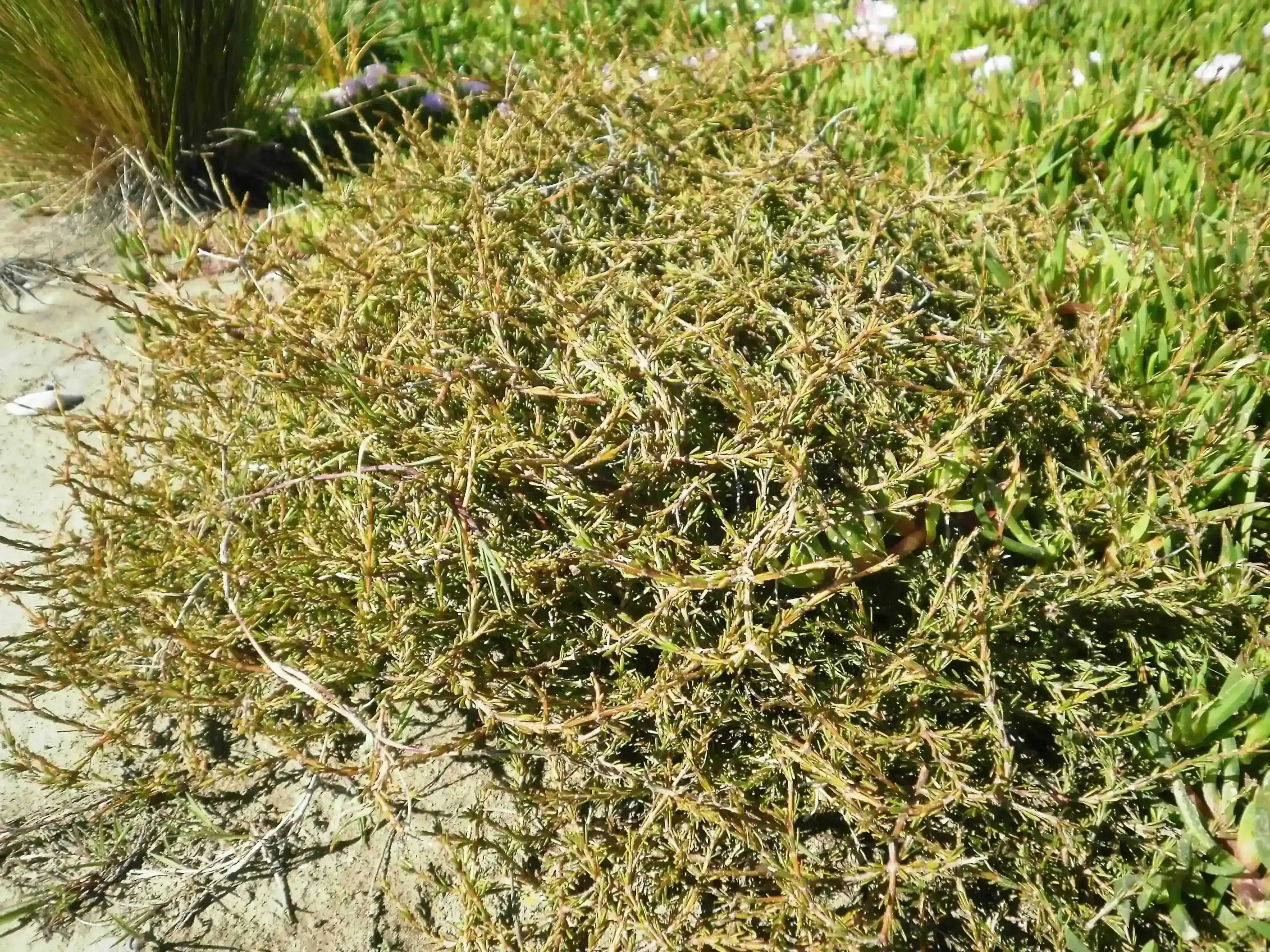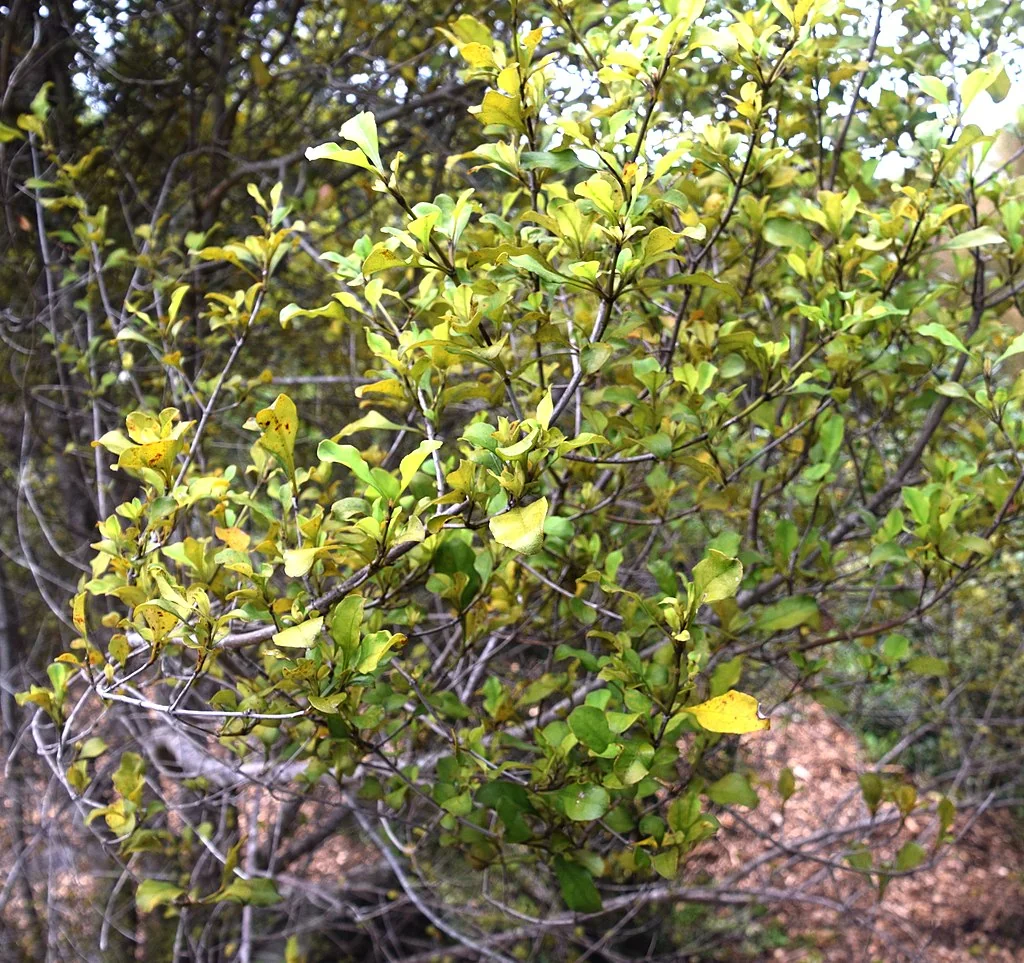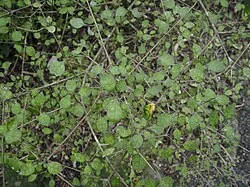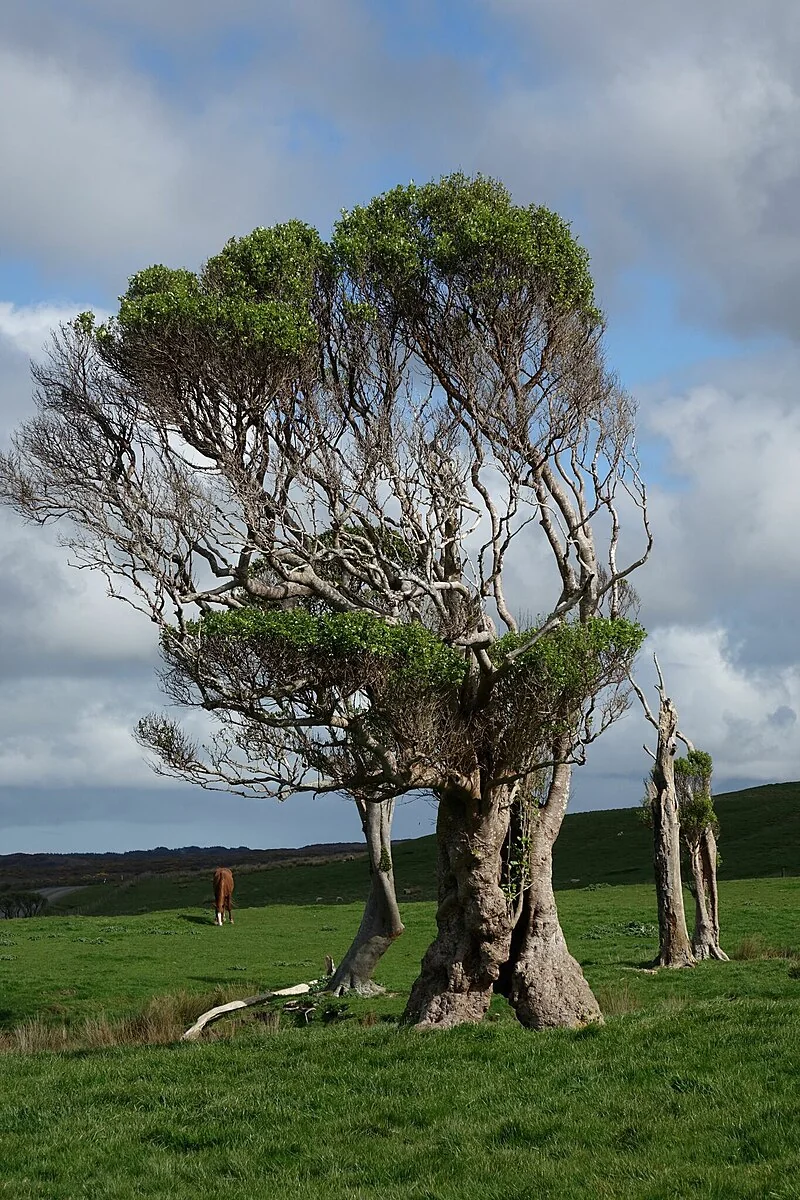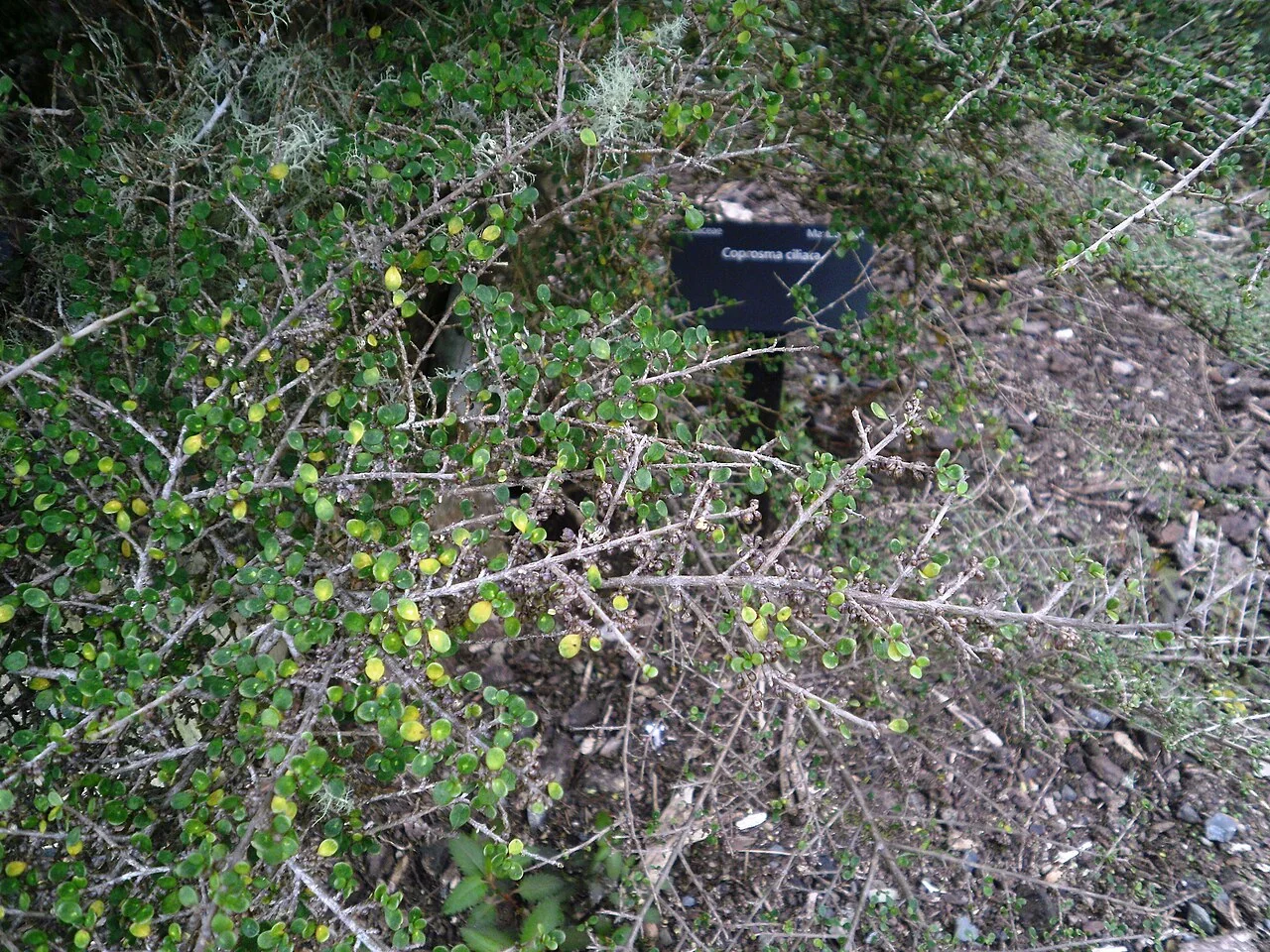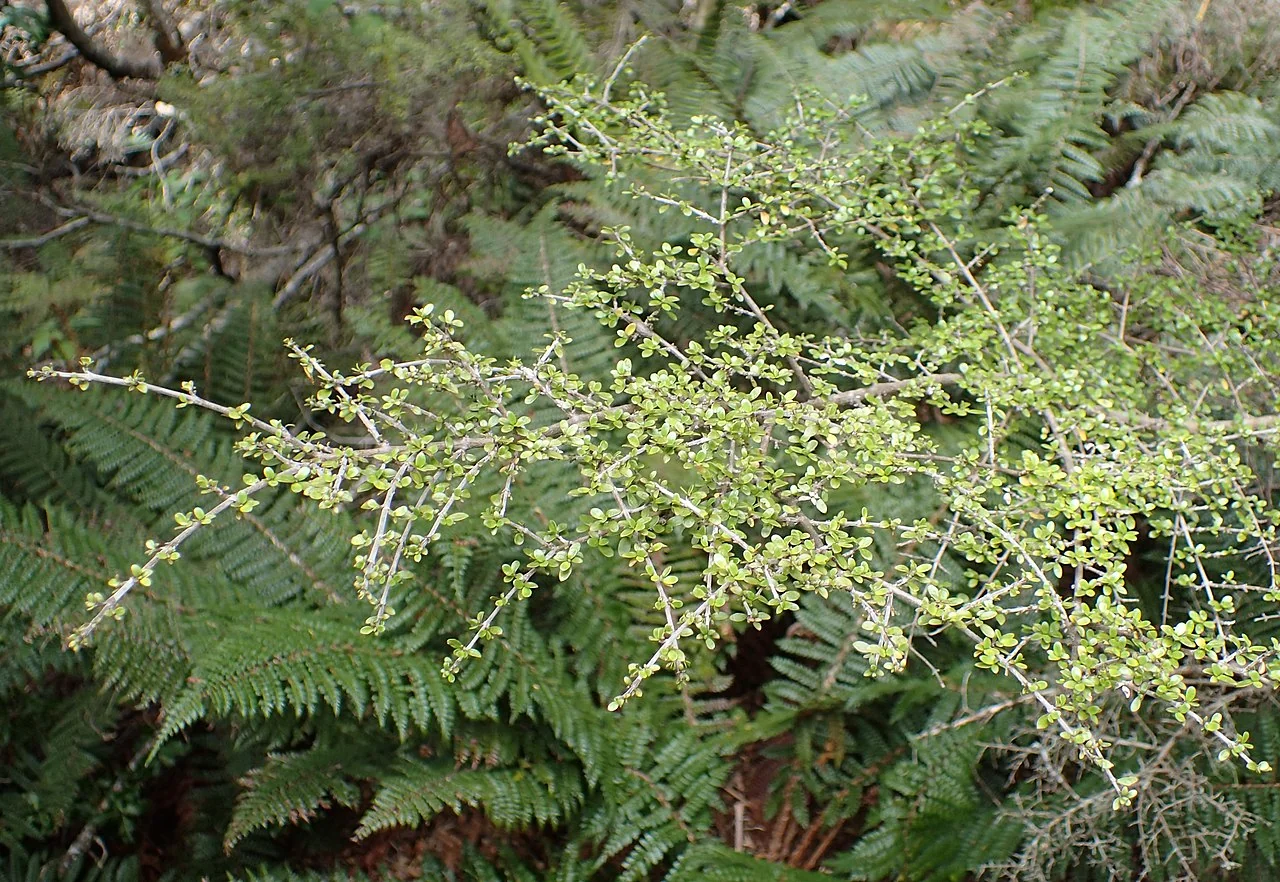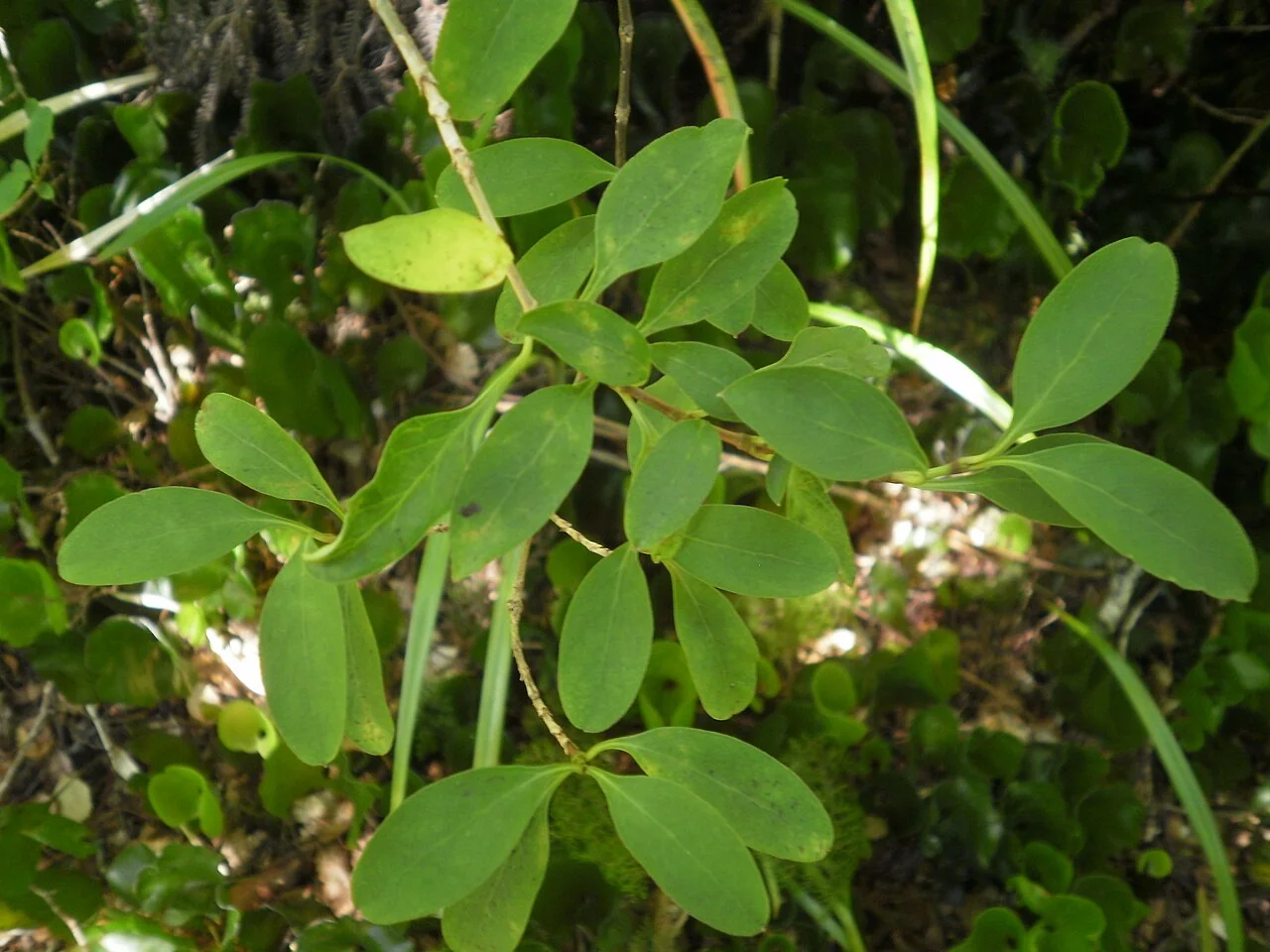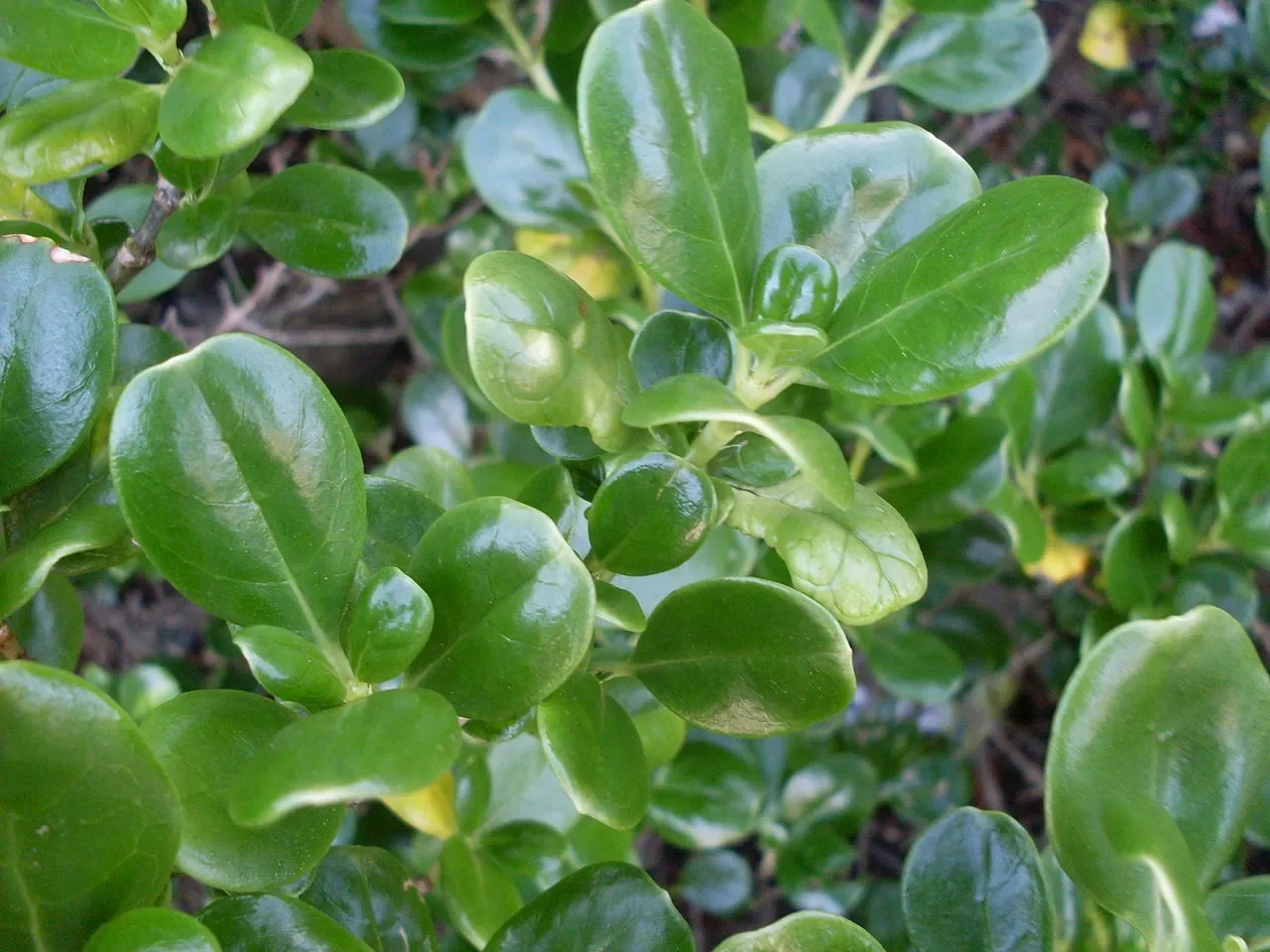
Mirror Plant
Coprosma repens
Coprosma repens , commonly known as mirror bush, looking-glass bush, New Zealand laurel, shiny leaf, or taupata, is a species of flowering shrub among New Zealand's native shrubs or small tree native to New Zealand. This evergreen plant is characterized by its thick, very glossy, and often leathery leaves, which can vary significantly in size depending on its exposure to the elements. Its growth habit is highly variable; in exposed areas like cliffs, it can grow prostrate, while in more sheltered locations, it can reach up to 8 meters (26 feet) in height as a small tree. It typically forms a dense, rounded bush, growing about 0.9 to 1.8 meters (3-6 feet) tall and wide. Coprosma repens is dioecious, meaning individual plants have either male or female flowers. Flowers are generally inconspicuous, small, and white or greenish-white, appearing in spring and summer. Female plants produce orange-red, ovoid drupes (fleshy berries) that are about 8-10 mm in diameter, typically in late summer to fall. The species is highly tolerant of salt spray and coastal winds, making it a popular choice for seaside gardens.

Plant Description
Botanical Features
Coprosma repens , commonly known as Mirror Plant, Mirror Bush, New Zealand Laurel, or Taupata, is a species of flowering shrub or small tree native to New Zealand. This evergreen plant is characterized by its thick, very glossy, and often leathery leaves, which can vary significantly in size depending on its exposure to the elements. Its growth habit is highly variable; in exposed areas like cliffs, it can grow prostrate, while in more sheltered locations, it can reach up to 8 meters in height as a small tree. It typically forms a dense, rounded bush. The leaves are broad-oblong to broad-ovate, 2-8 cm long, and dark green on the upper surface, often with recurved margins and prominent small pits (domatia) on the lower surface. It is dioecious, with inconspicuous white or greenish-white flowers appearing in spring and summer. Female plants produce orange-red, ovoid drupes (berries) that are about 8-10 mm in diameter, typically in late summer to fall. The species is highly tolerant of salt spray and coastal winds, making it a popular choice for seaside gardens.
Quick Facts
| Scientific Name | Coprosma Repens |
|---|---|
| Height | 2-6 m |
| Spread | 2-4 m |
| Water Needs | Low |
| Light | Full sun to part shade |
| Frost Tolerance | Moderate |
| Salt Tolerance | Excellent |
| Growth Rate | Fast |
| Lifespan | Long |
Climate Best Suited to
Mirror Plant ( Coprosma repens ) is highly adaptable to coastal and inland conditions, tolerating salt spray and various soil types. It adapts well to typical New Zealand growing conditions with appropriate care and positioning.
Regional Suitability
| City | Climate Suitability |
|---|---|
| Whangārei | Ideal |
| Auckland | Ideal |
| Hamilton | Ideal |
| Tauranga | Ideal |
| Rotorua | Ideal |
| Gisborne | Ideal |
| New Plymouth | Ideal |
| Napier | Ideal |
| Whanganui | Ideal |
| Palmerston North | Ideal |
| Wellington | Ideal |
| Nelson | Ideal |
| Christchurch | Ideal |
| Dunedin | Ideal |
| Invercargill | Ideal |
Natural Habitat
The Mirror Plant ( Coprosma repens ) is a quintessential coastal species, endemic to New Zealand and found along the coastlines of the North, South, and Stewart Islands, as well as the Kermadec Islands. Its natural habitat is intrinsically linked to the sea, as it thrives in environments exposed to salt-laden winds and coastal spray. It is commonly found clinging to coastal cliffs, rock stacks, and boulder fields, where its prostrate form helps it withstand the harsh conditions. In more sheltered areas, it can grow into a small, bushy tree, often forming a significant part of the understorey in coastal forests. While it is predominantly a coastal plant, it has been known to venture inland in a few specific, low-lying areas. Its exceptional tolerance for salt and wind makes it a dominant species in many coastal plant communities and a crucial player in the stabilization of coastal ecosystems.
Plant Conservation
Coprosma repens , also known as taupata, mirror bush, or shiny leaf, is native to New Zealand, specifically the North Island, South Island, Kermadec Islands, and Three Kings Islands. In its native range, its conservation status is "Not Threatened" according to the New Zealand Threat Classification System (NZ TCS).
However, outside of its native New Zealand, Coprosma repens has become naturalized and is considered an environmental weed in several regions, including coastal areas of Victoria, New South Wales, South Australia, Western Australia, and Tasmania in Australia, as well as Norfolk Island, Hawaii, California (USA), and South Africa. It is actively managed as a weed in some of these areas due to its ability to form dense clumps that impede the growth of native plants.
Growing Requirements
Soil Requirements
Mirror Plant ( Coprosma repens ) performs best in well-draining soil that retains adequate moisture. Like most New Zealand natives, it prefers soils that don't become waterlogged but maintain consistent moisture levels. Good drainage is essential for healthy root development.
- Well-draining soil essential for healthy growth
- Prefers consistent moisture without waterlogging
- Adapts to various soil types with good drainage
- Benefits from organic matter incorporation
- Mulching helps retain moisture and suppress weeds
Light Requirements
Mirror Plant ( Coprosma repens ) performs well in full sun to partial shade conditions. Like many New Zealand natives, it adapts to various light conditions but typically shows best growth and form in positions that receive adequate sunlight throughout the day.
- Full sun to partial shade positions
- At least 4-6 hours of direct sunlight daily
- Tolerates light shade in warmer climates
- Morning sun particularly beneficial
Water Requirements
Mirror Plant ( Coprosma repens ) requires regular watering during establishment, typically for the first 1-2 years. Once established, it becomes more drought-tolerant but benefits from consistent moisture during dry periods. Avoid overwatering which can lead to root problems.
- Regular watering during establishment phase
- Moderate drought tolerance once established
- Consistent moisture during dry periods beneficial
- Avoid waterlogged conditions
- Mulching helps conserve soil moisture
Planting Guide
When to Plant
The best time to plant Mirror Plant ( Coprosma repens ) is in spring or autumn, allowing the plant to establish before extreme weather.
Site Selection and Soil
- Sunlight: Thrives in full sun to partial shade. More sunlight encourages brighter leaf colours, especially in variegated varieties. In hotter regions, some protection from the strong afternoon sun may be beneficial.
- Soil: Plant in moist, well-drained soil with a neutral to slightly acidic pH. It can adapt to calcareous soils but prefers light terrain rich in organic matter. If your soil is heavy or clay-based, improve its texture by adding gypsum, siliceous sand, perlite, or expanded clay to enhance aeration and prevent root rot.
- Exposure: It's highly tolerant of salt spray and coastal winds, making it an excellent choice for seaside gardens. While it can handle light frosts, it generally prefers warmer climates.
Planting Steps
- Dig a hole twice as wide as the root ball and just as deep.
- Enrich the soil with compost, aged manure, or an organic plant food.
- Gently tease the roots and cut away any circled or tangled roots before positioning the plant in the hole.
- Backfill with soil, gently firming it down.
- Form a raised ring of soil around the plant's root zone to help retain water. Water deeply immediately after planting to settle the soil and keep it moist for several weeks until the new plant establishes.
Ecological Role
Coprosma repens , also known as mirror plant or looking-glass plant, plays a dual ecological role depending on its geographic location. In its native New Zealand, it is an integral part of coastal ecosystems, while in other regions, it is considered an invasive species.
In Its Native Habitat (New Zealand):
- Coastal Ecosystem Integration: It is a common feature of coastal environments such as rock stacks, islets, coastal cliffs, and coastal forests, where it can form a significant part of the understorey or even co-dominate the canopy.
- Food Source: Its berries serve as a food source for birds, particularly during winter, contributing to local wildlife support.
- Shelter: The plant's dense growth offers shelter for small animals.
- Adaptation: It exhibits high tolerance to salt spray, coastal winds, and drought, making it well-adapted to harsh seaside conditions. It can also regenerate from its roots after fires.
In Introduced Regions (Invasive Species):
- Invasive Spread: It is classified as an invasive environmental weed in various regions, including parts of Australia (Tasmania, South Australia, New South Wales, Victoria), South Africa, and the United States (California, Hawaii).
- Competition: As an invasive species, it can rapidly spread and outcompete native vegetation, leading to dense, species-poor stands that shade out other plants.
- Habitat Disruption: Its unchecked growth can obstruct seabird burrowing, disrupt natural plant succession in coastal areas, and compact soil, reducing burrowing opportunities for native fauna.
- Hybridization: It can hybridize with endemic Coprosma species, threatening their genetic integrity and survival.
- Threat to Native Flora: Even within New Zealand, if introduced to areas outside its natural range, it can establish from garden plantings and pose a threat to indigenous Coprosma populations and local coastal vegetation.
Uses and Significance
Garden Uses
- Excellent for native plant gardens and restoration
- Suitable for naturalistic landscape designs
- Low maintenance once established
- Contributes to local biodiversity
- Attractive to beneficial native wildlife
Landscaping Uses
Garden Design Applications
Coprosma repens , also known as mirror plant, looking-glass bush, or New Zealand laurel, is a versatile evergreen shrub or small tree highly valued in landscaping for its glossy, leathery leaves and adaptability. Its uses range from coastal plantings to hedges and container specimens, with numerous cultivars offering a variety of foliage colours.
- Coastal Gardens: Due to its high tolerance to salt spray and wind, Coprosma repens is an excellent choice for coastal and seaside gardens.
- Hedges and Screens: Its dense growth and vigor make it suitable for creating visual barriers, windbreaks, or small hedges.
- Container Plantings: The plant's attractive foliage and manageable size make it ideal for large pots on terraces, patios, and balconies, providing year-round colour.
- Specimen Plant: It can be used as a solitary specimen to highlight garden corners, especially when combined with other plants that have contrasting foliage or intense flowering.
- Mass Plantings: Varieties like 'Pacific Sunset' are stunning in mass plantings.
- Foliage Interest: The vibrant and often colourful foliage of Coprosma repens cultivars is a primary reason for its use, adding year-round interest to gardens. The leaves are also prized in floral arrangements.
- Wildlife Attraction: The berries produced by female plants attract birds, particularly in winter, making it valuable for supporting local wildlife.
- Erosion Control: In exposed situations where it adopts a prostrate habit, it can be useful for stabilizing soil.
Seasonal Care Calendar
Spring
Spring is an active growth period for Mirror Plant ( Coprosma repens ). New growth emerges and this is an ideal time for planting new specimens. Monitor soil moisture as temperatures warm and growth accelerates.
- Active growth period with new foliage development
- Ideal time for planting new specimens
- Monitor soil moisture as temperatures rise
- Apply organic mulch if needed
Summer
Summer is typically the main growing season for Mirror Plant ( Coprosma repens ). Ensure adequate watering during hot, dry periods, especially for young plants. Established plants show good heat tolerance with appropriate care.
- Peak growing season with active development
- Monitor watering needs during hot weather
- Young plants need consistent moisture
- Established plants show good heat tolerance
Autumn
During autumn, Mirror Plant ( Coprosma repens ) begins to slow its growth as temperatures cool. This is another good time for planting as conditions become more favorable. Reduce watering frequency but maintain soil moisture.
- Growth slows as temperatures moderate
- Good time for planting new specimens
- Reduce watering frequency gradually
- Maintain soil moisture without overwatering
Winter
Winter is typically a dormant period for Mirror Plant ( Coprosma repens ), with minimal growth activity. Reduce watering but ensure plants don't completely dry out. Most New Zealand natives are cold-hardy and require minimal winter protection.
- Dormant period with minimal growth activity
- Reduce watering but avoid complete drying
- Generally cold-hardy in most New Zealand climates
- Minimal winter protection required
When to Prune and How Much
Mirror Plant ( Coprosma repens ) generally requires minimal pruning to maintain its natural form and health. Most maintenance involves removing dead or damaged growth and light shaping if needed.
- Remove dead, damaged, or diseased growth as needed
- Light pruning to maintain shape if desired
- Prune after flowering if applicable
- Avoid heavy pruning which can stress the plant
- Use clean, sharp tools to prevent disease
- Most natives maintain good form without regular pruning
Always use clean, sharp tools when pruning to minimize disease risk. Native plants typically maintain their natural form well and often require less intervention than exotic species.
How to Grow Mirror Plant
From Fresh Orange-Red Berries
Fresh orange-red berry propagation represents the most reliable and natural method for growing Mirror Plant, taking advantage of this exceptional coastal species' prolific fruit production and natural dispersal strategy that has enabled it to establish across diverse New Zealand coastal environments. This hardy dioecious endemic produces abundant orange-red ovoid drupes from July through June that provide exceptional opportunities for propagation while supporting the species' natural frugivory dispersal cycles essential for coastal ecosystem function. The species' remarkable adaptation to coastal conditions including salt spray tolerance and wind resistance makes it particularly valuable for coastal restoration projects and challenging seaside gardens requiring resilient plants capable of handling extreme maritime conditions. Fresh berries yield significantly higher germination success compared to stored seeds, making immediate processing and sowing the preferred approach for both conservation propagation and coastal garden cultivation of this ecologically important coastal specialist. Collect ripe berries when fruits have achieved their characteristic orange-red coloration and can be easily removed from female plants, timing collection during the extended fruiting period when seeds have reached maximum viability for successful establishment. Choose berries that are fully developed, firm, and show the distinctive orange-red coloration typical of mature fruit, avoiding any that appear damaged, diseased, or prematurely dropped which might indicate compromised seed quality. Process berries immediately after collection by removing all flesh through thorough washing, using gentle rubbing under running water to separate seeds from fruit material that could inhibit germination or promote fungal growth during establishment. Clean seeds by repeated washing until all fruit debris is removed, retaining the seeds that settle to the bottom while discarding floating material that typically indicates poor viability or damaged genetic material. Prepare optimal germination medium using well-draining seed-raising mix with good moisture retention characteristics, ensuring pH levels between 6.0-7.0 that support healthy development for this adaptable coastal species. Sow fresh seeds immediately after processing, placing them on the surface of moist growing medium or covering lightly with 2-3mm of fine sand, as they benefit from some light exposure during germination while requiring protection from drying out. Provide optimal environmental conditions including consistent temperatures between 15-20°C and bright, indirect light that supports germination while maintaining even moisture without waterlogging throughout the germination period. Maintain careful moisture management throughout the 4-8 week germination period, ensuring growing medium remains consistently moist but never waterlogged while monitoring for early emergence signs that indicate successful seed activation. Young seedlings develop at moderate rates while establishing the robust root systems necessary for adaptation to coastal growing conditions, requiring protection from direct sunlight and environmental stress during early establishment phases. Transplant successful seedlings when they reach 5-8cm height and have developed sufficient root systems to handle coastal garden conditions, providing growing environments that support transition from nursery to permanent coastal locations where they can contribute to native plant communities. This easy propagation method makes Mirror Plant an excellent choice for coastal gardeners seeking reliable results with native plant cultivation while contributing to conservation efforts through expanding populations of this ecologically valuable coastal species that can self-sow and naturalize in suitable coastal environments.
From Semi-Hardwood Cuttings
Semi-hardwood cutting propagation offers an excellent vegetative method for growing Mirror Plant that preserves the exact genetic characteristics of superior parent plants while providing reliable results for both experienced propagators and beginners working with coastal native plant cultivation. This approach is particularly valuable for maintaining exceptional specimens that demonstrate superior salt tolerance, enhanced glossy leaf characteristics, or other desirable traits that can be preserved through careful vegetative propagation techniques suited to this hardy coastal species. The method works especially well with Mirror Plant because of this species' natural ability to develop adventitious roots under appropriate growing conditions, making it suitable for both commercial nursery production and home coastal gardening applications. Take semi-hardwood cuttings during late summer to early autumn when current season's growth has achieved optimal maturity for rooting while retaining sufficient vigor for successful establishment under controlled propagation environments. Select healthy, vigorous shoots from the middle portions of branches that display the characteristic thick, very glossy leaves and robust growth typical of healthy Mirror Plant development, avoiding both very soft growth and completely hardened wood that may resist rooting. Cut sections 8-12cm in length with clean, sharp secateurs, ensuring each cutting includes at least 2-3 nodes while selecting material that represents the best characteristics of the parent plant including compact growth habit and the distinctive mirror-like foliage that characterizes this species. Remove lower leaves carefully to reduce transpiration stress while retaining sufficient photosynthetic capacity in upper leaves, taking care not to damage the thick, glossy leaves that provide energy for root development during the establishment period. Apply rooting hormone powder or solution immediately after preparation, using formulations appropriate for semi-hardwood coastal species to enhance root initiation while ensuring even coverage of cut surfaces where new root systems will develop. Insert prepared cuttings into well-draining cutting mix composed of equal parts quality propagation medium and coarse sand or perlite, ensuring excellent drainage while maintaining the consistent moisture levels essential for successful root development without creating waterlogged conditions. Maintain optimal environmental conditions including high humidity (75-85%) and consistent temperatures around 18-20°C using humidity domes, misting systems, or controlled environment facilities that support root development while preventing cutting stress. Provide bright, indirect light that supports photosynthesis without causing excessive transpiration stress, replicating the filtered light conditions where this species can thrive in coastal forest understory environments. Monitor cutting development throughout the 6-10 week rooting period, maintaining consistent environmental conditions while watching for signs of successful root development including new shoot growth and resistance when gently tested. Root development occurs gradually as cuttings establish the fibrous root systems characteristic of mature Mirror Plant adapted to coastal soils, requiring patience and consistent care throughout the establishment process. This method provides excellent results for maintaining specific genetic lines while contributing to conservation efforts that preserve the natural variation essential for healthy coastal plant populations in restoration and landscape applications, making it an ideal choice for coastal gardeners seeking to propagate superior forms of this valuable coastal species.
From Layered Pieces
Natural layering provides an excellent propagation method for Mirror Plant that takes advantage of this species' natural growth habit and flexible branching structure that often creates opportunities for vegetative reproduction in coastal environments where this hardy species naturally thrives. This technique works particularly well with Mirror Plant because of its ability to develop flexible shoots that can readily contact suitable growing medium, creating conditions favorable for adventitious root development under the challenging coastal conditions where this species naturally establishes. The method mimics natural reproduction strategies while providing reliable results for coastal gardeners seeking to propagate specific genetic lines using simple techniques that require minimal specialized equipment. Understanding this natural process provides insights into the species' coastal ecology while offering practical propagation techniques that work well in challenging coastal garden environments. Select healthy, flexible shoots from vigorous parent plants during the growing season when active growth supports rapid root development, choosing shoots that can be easily brought into contact with prepared growing medium while remaining connected to parent plants. Identify suitable layering locations where selected shoots can be positioned in contact with soil or growing medium while maintaining connection to the parent plant's established root system throughout the critical establishment period. Prepare layering sites by incorporating organic matter and ensuring adequate drainage characteristics that support root development while preventing waterlogged conditions that can inhibit successful establishment in coastal soils. Create partial wounds in shoot sections that will be buried by making small cuts or scraping away bark to expose cambium tissue where new roots will develop most readily without severely damaging the layering material. Secure wounded shoot sections in contact with prepared growing medium using wire pins, small stones, or specialized layering pegs, ensuring consistent contact while allowing natural growth processes to proceed without excessive mechanical restriction. Cover layered sections with 5-10cm of well-draining growing mix enriched with organic matter, providing growing conditions that support rapid root development while maintaining the moisture levels necessary for successful establishment of this coastal species. Mark layering sites clearly to prevent accidental disturbance and maintain consistent moisture throughout the growing season, as reliable water availability is critical for root development in this species that requires careful moisture management for optimal coastal growth. Monitor layered sections regularly for signs of successful rooting, typically indicated by new shoot growth emerging from covered areas after 6-12 months under favorable coastal conditions, before attempting to sever connections to parent plants. This method provides excellent success rates with relatively simple techniques while maintaining the genetic characteristics of superior parent plants, making it ideal for coastal gardeners seeking to contribute to Mirror Plant conservation through expanding coastal populations with minimal specialized equipment or advanced propagation skills. Layered pieces establish readily and can quickly develop into robust coastal specimens capable of contributing to natural coastal plant communities where this species often self-sows and naturalizes in suitable maritime environments.
Pests and Diseases
Coprosma repens , also known as Mirror Plant, is generally a robust plant, but it can be susceptible to certain pests and diseases.
Common Diseases:
- Root rot: Is the most frequent issue, typically caused by overwatering or inadequate drainage. Ensuring well-draining soil and avoiding excessive watering, especially during cooler months, is crucial for prevention.
- Leaf spot: A fungal infection, can manifest as spots on the leaves and is often worsened by wet conditions. Improving air circulation and avoiding overhead watering can help.
- Other fungal growths: Can occur, and if they appear, transplanting the plant into fresh soil and removing infected areas may be necessary.
- Dieback: On the ends of stems can also affect Coprosma repens , sometimes more noticeably in sheltered locations.
Common Pests:
- Aphids, spider mites, mealybugs, and whiteflies: Are common nuisances. These can often be dislodged with a strong spray of water or treated with insecticidal soap if the infestation is severe.
- Scale insects: Can occasionally cause damage.
- Flea beetle: Endemic to New Zealand, feeds on the leaves of Coprosma.
- Coprosma white erineum mite (Phyllocoptes coprosmae): Induces white, hair-like growths (erineum) on the underside of the leaves.
Other Potential Problems:
- Leaf discoloration: Such as yellowing, can indicate poor nutrition, specifically a lack of nitrogen or iron.
- Variegated varieties: May revert to green if they do not receive enough light.
- Severe frost: Can damage the foliage, while somewhat frost-tolerant.
- Leaf drop: Can occur in response to sudden temperature changes.
Cultural Significance
Traditional Uses and Values
Mirror Plant, or Taupata ( Coprosma repens ), holds cultural significance for Māori as a resilient coastal plant. Its tough, glossy leaves were traditionally used for various purposes, including medicinal applications (rongoā) and as a source of dye. Its ability to thrive in harsh coastal environments also made it a symbol of strength and adaptability, contributing to traditional ecological knowledge and resource management.
Bonus Tip
Expert Growing Advice
Coprosma repens , also known as Mirror Plant, is named for its incredibly glossy, leathery leaves that reflect light like mirrors. This adaptation helps it survive in its native coastal habitats by reducing water loss and protecting against harsh sunlight. Its growth habit is highly variable; in exposed areas like cliffs, it can grow prostrate, while in more sheltered locations, it can reach up to 8 meters as a small tree. This versatility, combined with its exceptional tolerance to salt spray and coastal winds, makes it a fascinating and resilient plant.
